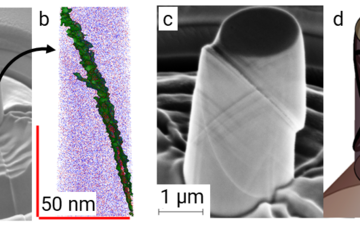All genres
21.
Talk
Ultra-high strain rate nanoindentation and micro compression. FEMS Euromat, Frankfurt, Germany (2023)
22.
Talk
Dynamic Testing of Iron-Aluminium Alloy Microparticles Fabricated using a Solid-State Dewetting. FEMS EUROMAT 2023, Frankfurt, Germany (2023)
23.
Talk
Dynamic Cryo-Mechanical Properties of Dewetted Nickel Microparticles. TMS 2023 152nd Annual Meeting and Exhibition, San Diego, CA, USA (2023)
24.
Talk
High strain rate testing of copper based micropillars and microlattices. 206 Departmental Seminar Series, Empa, Thun, Switzerland (2021)
25.
Talk
Small scale mechanical characterization. Small scale mechanics course, RUB, Bochum, Germany (2021)
26.
Talk
Pushing the limits of microscale manufacturing and mechanical testing. Department of Material Science and Engineering Seminar Series, Tel-Aviv University, online, Tel-Aviv, Israel (2021)
27.
Talk
Micro/nanoscale fabrication techniques. Small scale mechanics course, RUB, Bochum, Germany (2021)
28.
Talk
High strain rate testing from micro-to-meso scale. MRS Spring 2021 Conference - In Situ Mechanical Testing of Materials at Small Length Scales, Modeling and Data Analysis Symposium, online (2021)
29.
Talk
High strain rate micromechanics: Instrumentation and implementation. DGM - Arbeitskreis Rasterkraftmikroskopie und nanomechanische Methoden, online (2020)
30.
Poster
Effect of Defects on the Dynamic Compression of Strontium Titanate Micropillars. ECI Nanomechanical Testing in Materials Research and Development IX, Sicily, Italy (2024)
31.
Poster
Copper micro-honeycomb architectures: fabrication, characterization and high strain rate testing. ECI Nanomechanical Testing in Materials Research and Development IX, Giardini Naxos, Messina (Sicily), Italy (2024)
32.
Poster
High strain rate nanoindentation on a low angle grain boundary in copper. ECI Nanomechanical Testing in Materials Research and Development IX, Giardini Naxos, Messina (Sicily), Italy (2024)
33.
Poster
Insights into Dynamic Hardness of B2 Iron Aluminide using Ultra-high Constant Indentation Strain Rate Testing. Structural Nanomaterials, Gordon Research Conference, Les Diablerets, Vaud (fr), Switzerland (2024)
34.
Preprint
High Strain Rate Compressive Deformation Behavior of Nickel Microparticles. arXiv (2024)
35.
Preprint
Probing Elastic Isotropy in Entropy Stabilized Transition Metal Oxides: Experimental Estimation of Single Crystal Elastic Constants from Polycrystalline Materials. arXiv (2024)
36.
Preprint
Fabrication and extreme micromechanics of additive metal microarchitectures. ArXiv (2023)
37.
Preprint
Green laser powder bed fusion based fabrication and rate-dependent mechanical properties of copper lattices. arXiv (2022)











